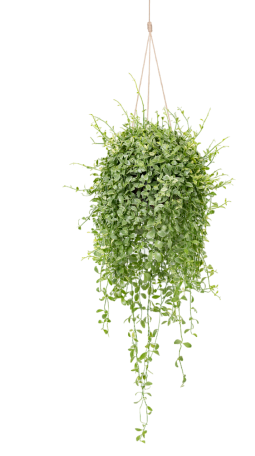Why do my sheets smell so good after drying them on the clothesline?

Last night, I was SHOCKED (in a good way). I had been trying everything to avoid going to the doctor for a lingering sinus problem that caused me to wake up in the mornings with a raging headache (and twice in one week, nausea–yuck!) Rinsed sinuses with a neti pot, check. Turned on ceiling fan at night. Turned off ceiling fan at night. Changed sheets. Used essential oils. Used herbal supplements. Things were getting clearer. Then I remembered that I hadn’t washed the comforter in a while; maybe there were dust mites in it (I had encased my mattress and boxspring and pillows last year, so that was not an issue). Into the wash goes the comforter with some unscented laundry detergent, and since it was a nice day, I decided to haul it up on my parents’ clothesline to get some drying time in the sun. When I climbed into my bed last night… WOW! What is that fresh smell on the comforter? I mean—really naturally fresh!
I do live in the country, so unless the winds are blowing the wrong way from the nearby farm or someone decides to burn some leaves, the air is usually good. But, my home is shaded by large trees that make a clothesline impractical, so I had forgotten how good line-dried laundry smells. There really is nothing like it, so what is going on when we put laundry in the sun and fresh air?
It’s really a physical and chemical process, albeit a “natural” one, that is going on when you hang wet fabric out to dry in the sun. In a 2020 study, researchers compared the emitted compounds from towels dried outdoors, indoors, and outdoors but not exposed to sunlight. They put each of the samples into sealed bags and analyzed the emitted compounds by using thermal desorption-gas chromatography/mass spectrometry (TD-GC/MS). A variety of aldehydes (oxidized alcohols) such as pentanal, hexanal, heptanal, octanal, and nonanal were found coming from the towels that were dried outside, which were not observed in the other conditions. Guess what? Many of these compounds are generally pleasant-smelling. For example, pentanal, found in cardamom, octanal, which produces citrusy aromas, and nonanal, which smells roselike. (How Line-Dried Laundry Gets That Fresh Smell)
How are these aldehydes created, exactly? The lead researcher Silvia Pugliese theorized that the UV wavelengths in natural sunlight create radicals from certain molecules in the air, recombine with other nearby molecules, processes that often lead to the creation of aldehydes as well as ketones. On the surface of the wet towel, the water acts as a magnifying glass, concentrating the sunlight and speeding up these reactions. Exposure to ozone in the atmosphere may also convert common chemicals to aldehydes and ketones. The aldehydes are “polar” molecules, meaning that one end of the molecule is positively-charged, and the other is negatively-charged. Such molecules tend to make hydrogen bonds with the cotton fibers, making the smell last longer.
The experiments indicate that both UV light and the presence of liquid water are necessary to generate these odors. It's photo-oxidation occurring on the surface of the wet fabric that makes the laundry cleaner (UV light kills most microbes) and smell good.
We’ve written a lot about these radicals in the atmosphere, including in this article. Radicals are very short-lived, and to the human body, they’re actually not very good because they cause oxidation, or the transfer of electrons from the oxidized substance to the radical. On an iron surface, this causes rust, and on human skin, it breaks down the oils that moisturize and protect the skin. Thankfully we now know not to stay in the sun for very long without UV protection!
Are aldehydes and ketones actually good to breathe in? Yes and no. Technically they are not good in concentration, but since they account for a large proportion of pleasant smells that we experience, we get a lot of pleasure from them! Aldehydes are in floral and citrusy perfumes. Aldehydes and ketones are in cooking emissions. One 2015 study even ranked the concentration of aldehyde and ketone compounds in the exhaust of Beijing restaurants in descending order, and it made me crave Chinese food by just reading it! Roast duck > Chinese barbecue > Home cooking > Western fast food > School canteen > Chinese fast food > Sichuan cuisine > Huaiyang cuisine. The lesson here? High cooking heat and UV light seem to be doing similar things by breaking down and changing molecules to make aldehydes and ketones, and in the case of the kitchen, use the exhaust vent whenever you cook! In the same way, some people are sensitive to these aldehyde fragrances, and so may not prefer drying in the clothes dryer to drying outside.
The downsides of line-drying clothing outdoors also include fading of colors and some breakdown of the fibers over time. Also, allergy sufferers must be careful not to hang laundry outside on high pollen days. Bird poop is a less common hazard, but still exists. Is it possible to get the outside smell from drying inside? Detergent companies like Procter and Gamble claim to have unique formulas in their fabric conditioners that give the same smell, but that’s not natural to me. Then, you have a startup that has patented several designs using UV lights surrounding a transparent drying drum, and various small dryers that use UV light in some part of their cycles. I highly doubt I could get the same smell on a large item like a comforter using these!
What will I be doing? I admit I went from being a loyal clothesline fan in my 30’s, to a “I’ve got better things to do with my time” in my late 40’s. But now, the scent of a naturally-fresh comforter has me in love with the clothesline again. I’ll be schlepping my sheets and comforters to the clothesline whenever I can!
Photo by Félix Prado on Unsplash






